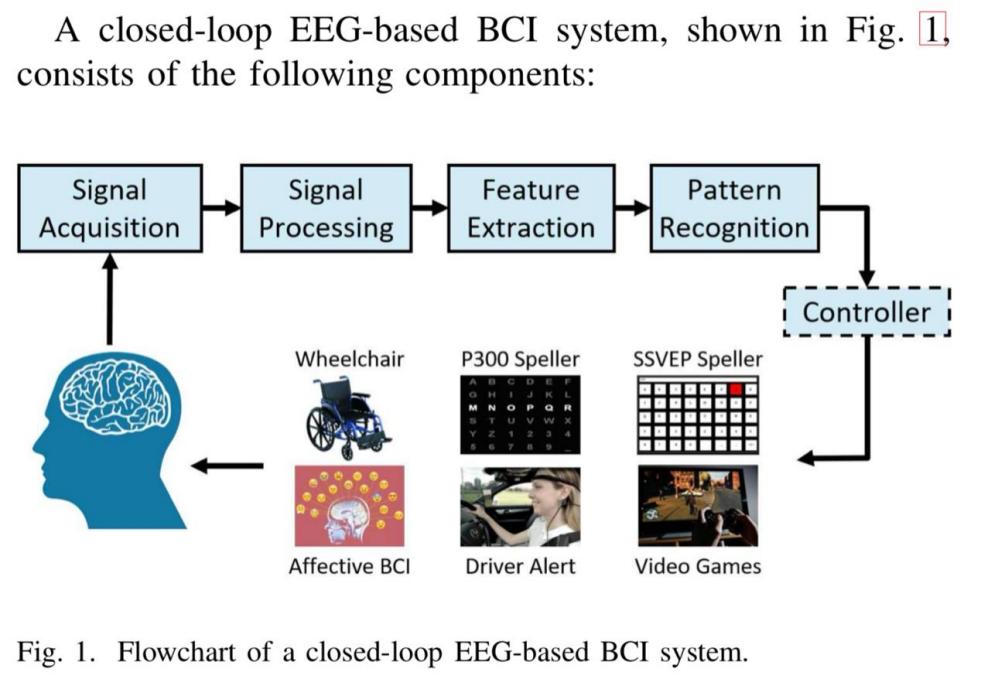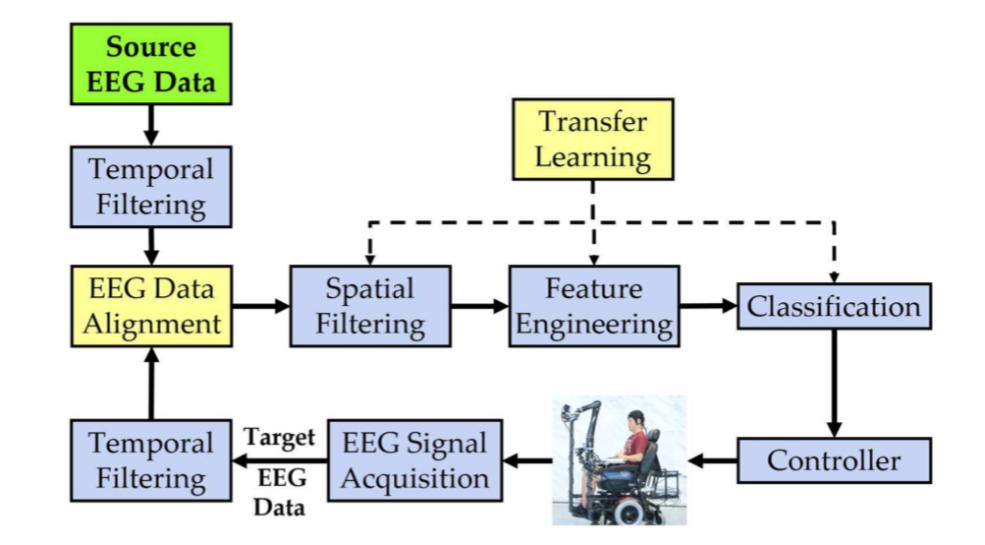1. Introduction
Improvements in machines have led to a revolution in neurological diseases. From medication to mechanical assistance, machine-assisted therapy has now become an effective method to treat diseases involving abnormal neural connection function. EEG-based brain-computer interfaces are one of the most widely used non-invasive methods. BCI, being subdivided into closed-loop and opened-loop, is a system that measures brain activity and converts it into functional useful output.
While open - loop BCI only collects and analyzes signals of human brain activities, closed - loop BCI adjusts the mechanism of the machine to make it more suitable for human behavior. As a result, the system provides rehabilitation robotics and receives sensory feedback controlled by the end - user to promote stimulatory neuroplasticity - based reorganization of the motor - related brain regions [1]. Based on the effectiveness of the closed-loop brain-computer interface mechanism------ adjusting the data of the external connection machine according to the data of the brain activity to help humans act better; it is actually considered to be a new method with great potential for the treatment of Parkinson's disease, Epilepsy, Stroke and other neurological diseases [2].
This paper focuses on the Potential application of Closed-Loop BCI in the treatment of neurological diseases, in particular its framework and approach. The fundamental principle of closed - loop Brain - Computer Interface (BCI) and its potential value in the treatment of neurological diseases, as well as its current applications and potential future applications.
2. Principles and technical framework of closed-loop BCI
2.1. Framework of signal collection
An electroencephalogram (EEG) is a test that measures electrical activity in the brain. BCI collects brain activity through EEG, then analysis the data. A closed-loop EEG-based BCI system, shown in Fig.1 consists of the following components: [3]

Figure 1: Flowchat of a closed-loop EEG-based BCI system [3]
1) Signal acquisition: This process uses an EEG device to collect EEG signals from the scalp through various connection methods. Wired connections and gel were common for enhancing conductivity; currently, wireless connections and dry electrodes are becoming very popular[3].
2) Signal processing: EEG signals are weak and easily contaminated. This process usually applies methods like temporal and spatial filtering to improve the signal - to - noise ratio[3].
3) Feature extraction: It utilizes characteristics from the time domain, frequency domain, time - frequency domain, Riemannian space, and functional brain connectivity to represent EEG signals effectively [3].
4) Pattern recognition: It employs either a classifier or a regression model based on the application. Frequently used classifiers include linear discriminant analysis (LDA) and support vector machine (SVM)
5) Controller: It executes commands to operate external devices (such as a wheelchair or a drone) or adjust environmental properties (like changing the difficulty level of a video game)[3].
2.2. Approaches of closed-loop EEG-based BCI
For different users of closed-loop BCI, their EEG is different. In order to get used to these difference, closed-loop BCI uses various approaches. One of the most promising such approaches is transfer learning (TL) which leverages data knowledge from source domains (existing subjects) to assist in calibrating the target domain (new subjects). TL can be applied to multiple components of a BCI system, and propose a complete TL pipeline for MI-based BCIs, shown in Figure 3 [4].
1) Time filtering, in which the source and target domain data are band-pass filtered [4].
2) Data alignment: Align EEG tests in the source and target domains to make their distribution more consistent. This is a new component that does not exist in Figure 2, but it will greatly facilitate TL in sequential components [4].
3) Spatial filtering, where TL can be used to design better spatial filters, especially when the amount of target domain labeled data is small [4].
4) Feature engineering, where TL may be used to extract or select more informative features [4].
5) Classification, where TL can be used to design better classifiers or regression models, especially when there are no or very few target domain labeled data [4].

Figure 2: A complete TL pipeline for closed-loop MI-based BCI systems [4]
3. Opportunities of closed-loop BCI apply to different neurological diseases
3.1. Application of closed-loop brain-computer interfaces in stroke rehabilitation
A stroke can occur when blood flow to the brain is blocked or there is sudden bleeding in the brain. There are two types of strokes: one is called a hemorrhagic stroke and the other is called an ischemic stroke.
While a hemorrhagic stroke occurs because of sudden bleeding in the brain which puts pressure on brain cells and damages them; the ischemic stroke appears differently. As the blood flow to the brain is blocked, the brain cannot get oxygen and nutrients from the blood. Without oxygen and nutrients, brain cells begin to die within minutes. The ischemic stroke then occurs [5].
Recent research showed that Closed-loop BCI technology has emerged as a promising tool in stroke rehabilitation. By continuously monitoring brain activity and providing real-time feedback, this technology offers a way to repair disrupted sensory-motor pathways. In patients with ischemic stroke, paralysis often leads to "learned non-use" of the affected limb, and Closed-loop BCI integrated with robotic systems and haptic feedback mechanisms can help restore dormant motor function. Similarly, in patients with hemorrhagic stroke, these systems compensate for sensory input lost due to brain cell damage, facilitating the restoration of motor planning and execution [1].
At the heart of the closed-loop BCI is the motion imagery (MI) principle, which enables the system to decode motion intentions from subtle brain signals, such as event-related desynchronization (ERD). Even if the body is unable to move, MI-based training allows the brain to actively participate in rehabilitation. This approach also has psychological benefits, providing stroke patients with encouragement and a sense of accomplishment that can ease depression and anxiety after a stroke [6].
Another compelling aspect of this technology is its ability to provide personalized, task-specific training. By capturing motion-related brain signals, such as event-related desynchronization ERD, and perceptual motor rhythm (SMR), BCIs can translate a patient's motor intentions into operational signals for external devices that help restore function in paralyzed limbs [1]. Then, By embedding exercises into real-world scenarios and tailoring feedback to individual brain activity, closed-loop BCI can not only accelerate functional recovery, but also enhance neuroplasticity. These systems bring a level of precision and adaptability that traditional rehabilitation methods cannot achieve, making them particularly effective for recovery from ischemic and hemorrhagic strokes. This technology transforms the landscape of stroke rehabilitation and offers new possibilities for regaining independence; thus improving patients' life quality.
3.2. Application of closed-loop brain-computer interface in paralysis rehabilitation
BCI can effectively improve the decoding accuracy of brain signals through advanced signal preprocessing and feature extraction technologies, such as common spatial pattern (CSP) and time-frequency analysis. To meet the individual needs of patients, the researchers have also developed deep learning-based classification algorithms such as convolutional neural networks (CNNS) and recurrent neural networks (RNNS), which significantly improve the BCIs' ability to recognize complex signals.
Therefore, the application of closed-loop BCI in patients with paralysis is promising. By recording motion-related cortical potentials (MRCP) and perceptual motor rhythm (SMR) in EEG signals, BCI is able to capture a patient's motor intentions and convert them into operational commands. This not only compensates for the lack of muscle control in paralyzed patients, but also enhances the brain's neuroplasticity through real-time feedback, speeding up the recovery process. Motor imagination (MI) is an important part of the closed-loop brain-computer interface. Even if a patient is physically unable to move, relevant brain signals can be activated by imagining movement, which offers the possibility of recovery. In addition, BCI can be combined with techniques such as transcranial direct current stimulation (tDCS) to regulate brain excitability and further improve efficacy [7].
4. Potential challenge of closed-loop BCI application
In recent years, BCI has shown great potential in the treatment and rehabilitation of these diseases, but it also faces many technical and ethical challenges.
4.1. Complexity of brain signals
Brain signals have non-stationary and high noise characteristics, especially in patients with neurological diseases, damaged brain regions may generate abnormal signals, which brings challenges to the decoding accuracy of BCI. In addition, the brain signal characteristics of different patients vary greatly, resulting in the need for individual debugging of the BCI system for each patient, increasing the cost and difficulty of implementation [6].
4.2. Limitations of classification algorithms
Traditional classification algorithms including linear discriminant analysis and support vector machines have limited effectiveness in processing complex brain signals. Although deep learning techniques, such as convolutional and recurrent neural networks, significantly improve decoding capabilities, their reliance on large data sets increases the difficulty of model training. Meanwhile, the computational complexity of deep learning models limits their wide application in real-time BCI systems [8].
4.3. Hardware technology bottlenecks
Non - invasive EEG devices are the most common means for BCI to acquire brain signals. However, their signal quality is restricted by external artifacts (e.g., myoelectric noise) and electrode stability. Although dry electrodes enhance device portability, the long - term signal - drift problem remains unsolved. In addition, the communication stability and power management of portable wireless EEG devices still need to be optimized [9].
4.4. Data security and privacy protection
With the widespread of BCI technology, data security and privacy concerns are becoming increasingly prominent. Electroencephalography (EEG), as a sensitive biological signal, involves users' private information, making the protection of this data from theft and misuse a significant challenge. Although existing biometric technologies provide some level of security, they still at risks of being imitation and duplication. This calls for an enhancement in protection mechanisms for biological signals while safeguarding privacy. In the future, by integrating more efficient encryption technologies and data protection solutions, BCI systems can offer a more secure user experience [10].
5. Conclusion
The application of Closed - loop BCI technology in treating neurological diseases represents an important advance in neurological rehabilitation. By integrating real-time monitoring, signal decoding, and feedback mechanisms, closed-loop BCI offers a dynamic and adaptable approach to functional recovery for patients with stroke, paralysis, and spinal cord injury. The system not only compensates for damaged neural pathways by converting brain activity into actionable outputs, but also enables long-term rehabilitation and functional improvement by promoting neuroplasticity.
Although closed-loop BCI shows great potential, its application still faces challenges such as signal complexity, hardware limitations, and personalized training requirements. In addition, ethical and privacy issues surrounding the use of brain data must also be addressed to ensure a responsible and transparent rollout of the technology. However, with advances in deep learning algorithms, non-invasive hardware, and real-time feedback techniques, these barriers are gradually being overcome, paving the way for more efficient, easy-to-use closed-loop BCI applications.
As closed-loop brain-computer interface systems continue to evolve, they are expected to promote neurological rehabilitation, leading to greater independence and a better quality of life for patients.
References
[1]. Wang, W., Collinger, J. L., Perez, M. A., Tyler-Kabara, E. C., Cohen, L. G., Birbaumer, N., ... & Weber, D. J. (2010). Neural interface technology for rehabilitation: exploiting and promoting neuroplasticity. Physical Medicine and Rehabilitation Clinics, 21(1), 157-178
[2]. Mang, J., Xu, Z., Qi, Y., & Zhang, T. (2023). Favoring the cognitive-motor process in the closed-loop of BCI mediated post stroke motor function recovery: challenges and approaches. Frontiers in Neurorobotics, 17, 1271967.
[3]. Wu, D., Xu, Y., & Lu, B. L. (2020). Transfer learning for EEG-based brain–computer interfaces: A review of progress made since 2016. IEEE Transactions on Cognitive and Developmental Systems, 14(1), 4-19
[4]. Wu, D., Jiang, X., & Peng, R. (2022). Transfer learning for motor imagery based brain–computer interfaces: A tutorial. Neural Networks, 153, 235-253. https://www.nhlbi.nih.gov/health/stroke
[5]. Craik, A., He, Y., & Contreras-Vidal, J. L. (2019). Deep learning for electroencephalogram (EEG) classification tasks: a review. Journal of neural engineering, 16(3), 031001
[6]. Mamunur Rashid (2020) Current Status, Challenges, and Possible Solutions of EEG-Based Brain-Computer Interface: A Comprehensive Review. Neurorobot
[7]. https://doi.org/10.3389/fnbot.2020.00025
[8]. [8] Korik, A., Sosnik, R., Siddique, N., & Coyle, D. (2019). Decoding imagined 3D arm movement trajectories from EEG to control two virtual arms—a pilot study. Frontiers in neurorobotics, 13, 94
[9]. Zangeneh Soroush, M., Maghooli, K., Kamaledin Setarehdan, S., & Nasrabadi, A. M. (2017). A review on EEG signals based emotion recognition. International Clinical Neuroscience Journal, 4(4), 118-129.
[10]. Campisi, P., & La Rocca, D. (2014). Brain waves for automatic biometric-based user recognition. IEEE transactions on information forensics and security, 9(5), 782-800.
Cite this article
Cao,Y. (2025). Potential Therapeutic Application of Closed-Loop Brain Computer Interfaces for the Treatment of Neurological Disorders: A Review and Methodological Framework. Theoretical and Natural Science,103,84-88.
Data availability
The datasets used and/or analyzed during the current study will be available from the authors upon reasonable request.
Disclaimer/Publisher's Note
The statements, opinions and data contained in all publications are solely those of the individual author(s) and contributor(s) and not of EWA Publishing and/or the editor(s). EWA Publishing and/or the editor(s) disclaim responsibility for any injury to people or property resulting from any ideas, methods, instructions or products referred to in the content.
About volume
Volume title: Proceedings of the 5th International Conference on Biological Engineering and Medical Science
© 2024 by the author(s). Licensee EWA Publishing, Oxford, UK. This article is an open access article distributed under the terms and
conditions of the Creative Commons Attribution (CC BY) license. Authors who
publish this series agree to the following terms:
1. Authors retain copyright and grant the series right of first publication with the work simultaneously licensed under a Creative Commons
Attribution License that allows others to share the work with an acknowledgment of the work's authorship and initial publication in this
series.
2. Authors are able to enter into separate, additional contractual arrangements for the non-exclusive distribution of the series's published
version of the work (e.g., post it to an institutional repository or publish it in a book), with an acknowledgment of its initial
publication in this series.
3. Authors are permitted and encouraged to post their work online (e.g., in institutional repositories or on their website) prior to and
during the submission process, as it can lead to productive exchanges, as well as earlier and greater citation of published work (See
Open access policy for details).
References
[1]. Wang, W., Collinger, J. L., Perez, M. A., Tyler-Kabara, E. C., Cohen, L. G., Birbaumer, N., ... & Weber, D. J. (2010). Neural interface technology for rehabilitation: exploiting and promoting neuroplasticity. Physical Medicine and Rehabilitation Clinics, 21(1), 157-178
[2]. Mang, J., Xu, Z., Qi, Y., & Zhang, T. (2023). Favoring the cognitive-motor process in the closed-loop of BCI mediated post stroke motor function recovery: challenges and approaches. Frontiers in Neurorobotics, 17, 1271967.
[3]. Wu, D., Xu, Y., & Lu, B. L. (2020). Transfer learning for EEG-based brain–computer interfaces: A review of progress made since 2016. IEEE Transactions on Cognitive and Developmental Systems, 14(1), 4-19
[4]. Wu, D., Jiang, X., & Peng, R. (2022). Transfer learning for motor imagery based brain–computer interfaces: A tutorial. Neural Networks, 153, 235-253. https://www.nhlbi.nih.gov/health/stroke
[5]. Craik, A., He, Y., & Contreras-Vidal, J. L. (2019). Deep learning for electroencephalogram (EEG) classification tasks: a review. Journal of neural engineering, 16(3), 031001
[6]. Mamunur Rashid (2020) Current Status, Challenges, and Possible Solutions of EEG-Based Brain-Computer Interface: A Comprehensive Review. Neurorobot
[7]. https://doi.org/10.3389/fnbot.2020.00025
[8]. [8] Korik, A., Sosnik, R., Siddique, N., & Coyle, D. (2019). Decoding imagined 3D arm movement trajectories from EEG to control two virtual arms—a pilot study. Frontiers in neurorobotics, 13, 94
[9]. Zangeneh Soroush, M., Maghooli, K., Kamaledin Setarehdan, S., & Nasrabadi, A. M. (2017). A review on EEG signals based emotion recognition. International Clinical Neuroscience Journal, 4(4), 118-129.
[10]. Campisi, P., & La Rocca, D. (2014). Brain waves for automatic biometric-based user recognition. IEEE transactions on information forensics and security, 9(5), 782-800.









